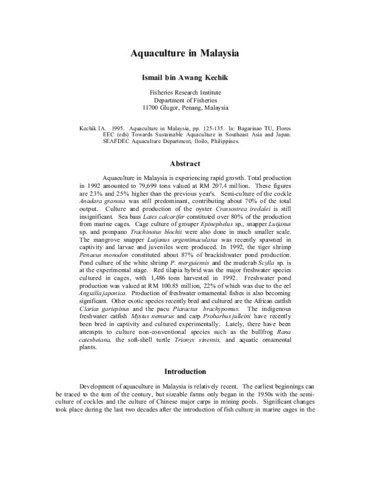Species and proximate composition of Laguna de Bay phytoplankton cultured in three different nitrogen-phosphorus ratios and their utilization by Nile tilapia
| dc.contributor.author | Cuvin-Aralar, Ma. Lourdes | |
| dc.contributor.author | Focken, Ulfert | |
| dc.contributor.author | Becker, Klaus | |
| dc.contributor.author | Santiago, Corazon B. | |
| dc.coverage.spatial | Bay, Laguna de | en |
| dc.date.accessioned | 2012-01-19T11:05:05Z | |
| dc.date.available | 2012-01-19T11:05:05Z | |
| dc.date.issued | 2001 | |
| dc.identifier.citation | Cuvin-Aralar, M. L., Focken, U., Becker, K., & Santiago, C. B. (2001). Species and proximate composition of Laguna de Bay phytoplankton cultured in three different nitrogen-phosphorus ratios and their utilization by Nile tilapia (Abstract only). In C. B. Santiago, M. L. Cuvin-Aralar, & Z. U. Basiao (Eds.), Conservation and Ecological Management of Philippine Lakes in Relation to Fisheries and Aquaculture (p. 161). Tigbauan, Iloilo, Philippines: Aquaculture Department, Southeast Asian Fisheries Development Center; Los Baños, Laguna, Philippines: Philippine Council for Aquatic and Marine Research and Development (PCAMRD), Department of Science and Technology; Quezon City, Philippines: Bureau of Fisheries and Aquatic Resources (BFAR), Department of Agriculture, Quezon City, Philippines. | en |
| dc.identifier.isbn | 9718511539 | |
| dc.identifier.uri | http://hdl.handle.net/10862/843 | |
| dc.description | Abstract only. | en |
| dc.description.abstract | Natural phytoplankton populations from Laguna de Bay were used in outdoor batch culture experiment in 1-ton capacity circular concrete tanks and 60-liter glass aquaria for a maximum duration of 72 days. The treatments consisted of the following nitrogen-phosphorus ratios: 2N: 1P, 6N: 1P, and 12N: 1P. The growth and species composition of phytoplankton were monitored in each of the three treatments. The phytoplankton were partially harvested at weekly intervals. The proximate composition of the freeze-dried harvest was also analyzed. The freeze-dried harvest was also used to feed Nile tilapia Oreochromis niloticus (L.) to determine effects of the different N-P ratios on the utilization of phytoplankton by fish. The fish were fed isonitrogenously and ration ranged from maintenance requirement for the first week to 3 times maintenance requirement for the succeeding weeks. Results showed that green algae, particularly the Chlorococcales group, dominated all the cultures. This was followed by diatoms. The blue-green algae consisted the third group in all treatments. Gross energy, crude protein, crude fat, neutral detergent fiber and crude ash content of the phytoplankton harvest did not vary significantly among treatments. However, crude protein expressed as percentage of organic matter was significantly higher in the treatment using 12N: 1P compared to those cultured in lower N-P ratios. Nile tilapia fed phytoplankton from 12N: 1P and 6N: 1P ratios showed significantly better growth than those fed with phytoplankton cultured in the lowest N-P ratio. | en |
| dc.language.iso | en | en |
| dc.publisher | Aquaculture Department, Southeast Asian Fisheries Development Center | en |
| dc.publisher | Philippine Council for Aquatic and Marine Research and Development (PCAMRD), Department of Science and Technology | en |
| dc.publisher | Bureau of Fisheries and Aquatic Resources | en |
| dc.subject | Oreochromis niloticus | en |
| dc.title | Species and proximate composition of Laguna de Bay phytoplankton cultured in three different nitrogen-phosphorus ratios and their utilization by Nile tilapia | en |
| dc.type | Conference paper | en |
| dc.citation.spage | 161 | |
| dc.citation.conferenceTitle | Conservation and Ecological Management of Philippine Lakes in Relation to Fisheries and Aquaculture: Proceedings of the National Seminar-Workshop held on October 21-23, 1997, INNOTECH, Commonwealth Ave., Diliman, Quezon City, Philippines | en |
| dc.subject.asfa | batch culture | en |
| dc.subject.asfa | culture media | en |
| dc.subject.asfa | feeding experiments | en |
| dc.subject.asfa | fish culture | en |
| dc.subject.asfa | cultured organisms | en |
| dc.subject.asfa | growth | en |
| dc.subject.asfa | phytoplankton culture | en |





